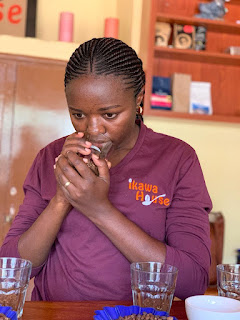Titled "Defining Defects" Ruth Ann reports on a variety of perspectives around the troubling fact that the word "defect" can mean so many different things. Q instructor Drew Billups of Drew Billups Consulting in Seattle, WA is quoted:
“Our definitions of defects in coffee can be messy. A physical green defect doesn’t necessarily mean a taste defect, and a taste defect doesn’t necessarily mean there is a visible green defect. Ideally, we would develop an improved vocabulary, so that we can be clearer in our communication about the different types.”
Perspectives from origin are included. For example, Laetitia Mukandihiro, an international cupping juror and veteran cupping instructor in Kigali, Rwanda, shares that she teaches her students that the terms of a green coffee contract are the true standards they need to know.
 |
Comments from an experienced Ethiopian exporter, Heleanna Georgalis, reveal that at origin, it's often a national coffee board standard that is a reference point, not the SCA green grading standard. In Ethiopia, the national Coffee Liquering Unit has a "defect points counting system" by which coffees are graded into the famous grades 1, 2, 3 and so on.
The article highlights that there is quite a learning curve about quality and defects for coffee professionals everywhere, especially those with green coffee buying power. Paul Ahn, head roaster at Madcap Coffee in Grand Rapids, Michigan, shares that he has become more concious over the years of the impact he has when he evaluates each cup.
“During each cupping where we evaluate a coffee for purchase, we have to be careful. Calling a defect is not the same as calling a fruit flavor. ‘Strawberry’ or ‘peach’ are not likely to negatively impact a farmer, but once you mark a defect, there’s a domino effect and an impact at origin. You might have no idea what that mark on the cupping form meant to them.”
 |
| Cupper at BJCU in Uganda. Credit: D. Billups |
The article shares Billups' story of coming up the learning curve during his effort to bring cupping traning to a cooperative in Uganda, Bukonzo Joint Coffee Union. Billups was the instructor helping the cooperative to better evaluate the value of their coffee. Billups found that deep experiences at origin forever shaped the way he thinks about quality and quality standards. Being close with producers at BJCU for one to two weeks at a time over a span of seven years, he gained new understanding of the level of difficulty involved in cultivating high quality coffee.
We will each travel our own path of discerning and learning about what "quality" means and what "defects" are in coffee. That path may be long -- perhaps, seven years, ten years or neverending. Hopefully, this article gives encouragement and inspiration to everyone to keep going on that journey!
 |
| Paul Ahn cupping. Photo credit: Erik Lauchie, Carbon stories. |

No comments:
Post a Comment